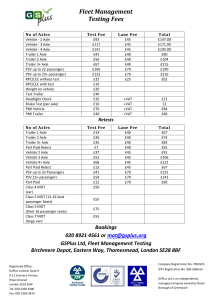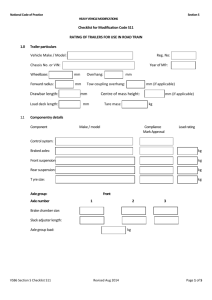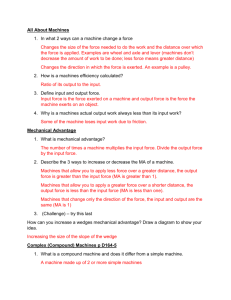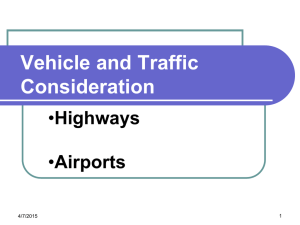Laos Road Network Additional Information
advertisement
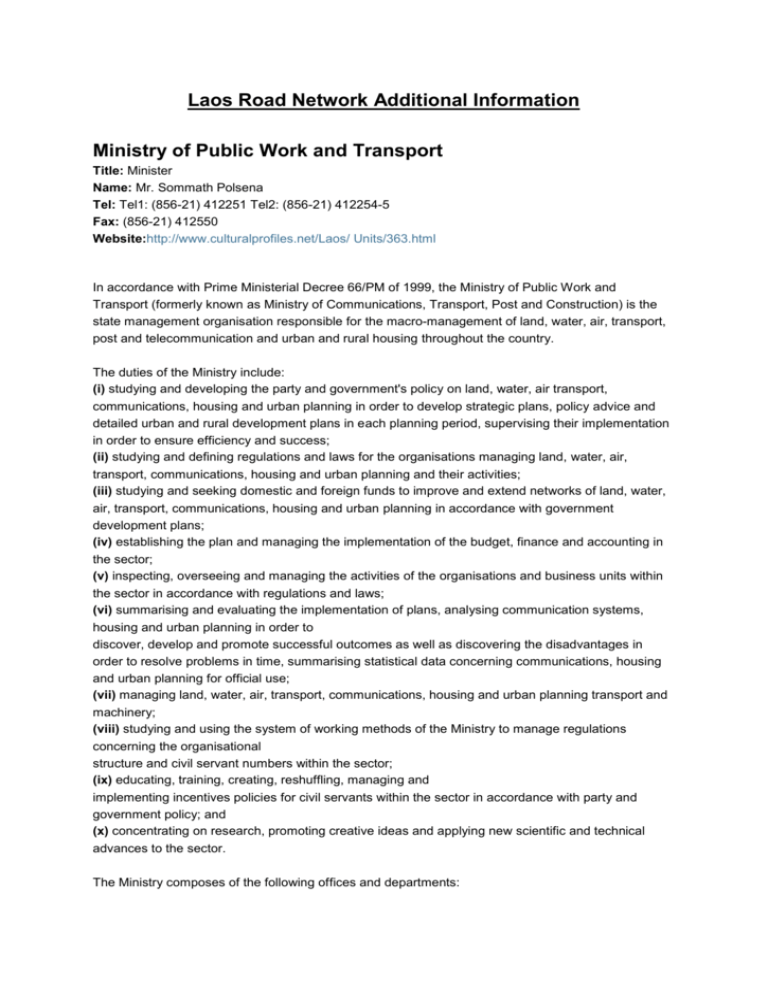
Laos Road Network Additional Information Ministry of Public Work and Transport Title: Minister Name: Mr. Sommath Polsena Tel: Tel1: (856-21) 412251 Tel2: (856-21) 412254-5 Fax: (856-21) 412550 Website:http://www.culturalprofiles.net/Laos/ Units/363.html In accordance with Prime Ministerial Decree 66/PM of 1999, the Ministry of Public Work and Transport (formerly known as Ministry of Communications, Transport, Post and Construction) is the state management organisation responsible for the macro-management of land, water, air, transport, post and telecommunication and urban and rural housing throughout the country. The duties of the Ministry include: (i) studying and developing the party and government's policy on land, water, air transport, communications, housing and urban planning in order to develop strategic plans, policy advice and detailed urban and rural development plans in each planning period, supervising their implementation in order to ensure efficiency and success; (ii) studying and defining regulations and laws for the organisations managing land, water, air, transport, communications, housing and urban planning and their activities; (iii) studying and seeking domestic and foreign funds to improve and extend networks of land, water, air, transport, communications, housing and urban planning in accordance with government development plans; (iv) establishing the plan and managing the implementation of the budget, finance and accounting in the sector; (v) inspecting, overseeing and managing the activities of the organisations and business units within the sector in accordance with regulations and laws; (vi) summarising and evaluating the implementation of plans, analysing communication systems, housing and urban planning in order to discover, develop and promote successful outcomes as well as discovering the disadvantages in order to resolve problems in time, summarising statistical data concerning communications, housing and urban planning for official use; (vii) managing land, water, air, transport, communications, housing and urban planning transport and machinery; (viii) studying and using the system of working methods of the Ministry to manage regulations concerning the organisational structure and civil servant numbers within the sector; (ix) educating, training, creating, reshuffling, managing and implementing incentives policies for civil servants within the sector in accordance with party and government policy; and (x) concentrating on research, promoting creative ideas and applying new scientific and technical advances to the sector. The Ministry composes of the following offices and departments: Cabinet of the Ministry Departments Aviation, Bridges and Roads, Housing and Urban Planning, Inspection, Organization and Personnel, Planning and Budgeting, Post and Communications, Transport. Organisations Railway Authority, Water Supply Authority Research Institutes Urban Research Institute (URI) State Enterprises Enterprise of Telecommunications Lao (ETL) Lao Telecommunications Co., Ltd Road Construction / Maintenance Lao government continues to depend upon the support of its development partners including World Bank, Asia Development Bank, SIDA, Japan/JICA, OPEC, IFAD, KFW, UNCDF and EU to implement rehabitation/reconstruction project in the transport sector. The costs of extending, upgrading and maintaining the transport system are very high. For example; the cost per kilometer of road varies dramatically, from over US$200,000 per kilometer to a low of US$20,000 depending of type of road and the terrain. The road maintenance fund (RMF), established under Decree Number No. 09/PM, 2001, is designed to ensure a sufficient and stable domestics source of revenue for road maintenance. Under the decree, 10% of RMF annual revenue is allocated to local road network (provincial, district and commodity roads), 0.5% to road safety programme, and up to 90%, after allowing administration cost of the fund, to national road. Average expenditure on the road network during the late 80’s was circa US$37 m per annum, this rose during the 90’s to an average of above US$60 m per annum. For the fiscal year 00/01 and 01/02 the budgetary to actual to disbursements were US$61.5 m to 44.9 m and US$34.6 m to 46.1 m respectively. Source: Country Report on Transport Logistics, MCTPC, May 2006 Road Construction / Maintenance Contacts Department of Bridges and Roads Title: Director Name: Mr. Viengsavat Siphandone Tel: (856-21) 412741 Fax: (856-21) 412250 Website: http://www.culturalprofiles.net/Laos/ Units/678.html The Department of Bridges and Roads is under Ministry of Public Work and Transport and responsible to the Minister for the provision of engineering direction, technical support and guidance in relation to the construction and maintenance of roads and bridges throughout the country Road Safety The number of accidents keep increased and the trends on steady raise in parallel with number of registered vehicle . According to official statistics in 2007, there number of accidents stood at 5, 198 which was nearly the same figures of 2003 of 5,177. This represents that the issue of road security in the country has not been decreased but on its rise. According to article 13 of the decree, violations shall be subject sanctions—“education, fine, or criminal punishment, in vague, based on the severity of their case…..and other such as: suspension of activities, withdrawal of operation license, closing enterprise or confiscation of vehicle “. In ideal practice, fine is the most common in unofficial negotiation. According to information gathering on the mode of fine being carried out is “fine” is calculated by multiply the “exceed weight” by distance (100,000 kip/km) from the point of origin of truck loading to “weighbridge station” per time at each station. Weigh limitation admission is considered in different seasons. The following are useful part of the decree. In dry season, from December 1st to May 31st , the maximum gross weight of all types and sizes of trucks, rigid truck, semi trailer truck and trailer, moving on any public road such as concrete road, asphalt concrete road, asphalt road, gravel road, earth road, natural road shall be as follow: RIGID TRUCK 1. Rigid truck with 2 axles 4 wheels, single front axle/single wheel and single rear axle/single wheel, shall not exceed 8,500 kg of which: Maximum front axle load: 1,700 kg / Maximum rear axle load: 6,800 kg * Front axle 1: 1,700 kg * Rear axle 1: 6,800 kg 2. Rigid Truck with 2 axles 6 wheels, single front axle/single wheel and single rear axle/dual wheel, shall not exceed 12,000 kg of which: Maximum front axle load: 2,900 kg / Maximum rear axle load: 9,100 kg * Front axle 1: 2,900 kg * Rear axle 1: 9,100 kg 3. Rigid Truck with 3 axles 6 wheels, single front axle/single wheel and dual rear axle/single wheel, shall not exceed 15,300 kg of which: Maximum front axle load: 3,100 kg / Maximum rear axle load: 12,200 kg * Front axle 1: 3,100 kg * Rear axle 1: 6,100 kg * Rear axle 2: 6,100 kg 4. Rigid Truck with 3 axles 10 wheels, single front axle/single wheel and dual rear axle/single wheel, shall not exceed 21,000 kg of which: Maximum front axle load: 4,600 kg / Maximum rear axle load: 16,400 kg * Front axle 1: 4,600 kg * Rear axle 1: 8,200 kg * Rear axle 2: 8,200 kg 5. Rigid Truck with 3 axles 6 wheels, dual front axle/single wheel and single rear axle/single wheel, shall not exceed 10,500 kg of which: Maximum front axle load: 3,700 kg / Maximum rear axle load: 12,200 kg * Front axle 1: 1,850 kg * Rear axle 1: 6,800 kg * Front axle 2: 1,850 kg 6. Rigid Truck with 3 axles 8 wheels, dual front axle/single wheel and single rear axle/dual wheel, shall not exceed 14,000 kg of which: Maximum front axle load: 4,900 kg / Maximum rear axle load: 12,200 kg * Front axle 1: 2,450 kg * Rear axle 1: 9,100 kg * Front axle 2: 2,450 kg 7. Rigid Truck with 4 axles 8 wheels, dual front axle/single wheel and dual rear axle/single wheel, shall not exceed 18,800 kg of which: Maximum front axle load: 6,600 kg / Maximum rear axle load: 12,200 kg * Front axle 1: 3,300 kg * Rear axle 1: 6,100 kg * Front axle 2: 3,300 kg * Rear axle 2: 6,100 kg 8. Rigid Truck with 4 axles 12 wheels, dual front axle/single wheel and dual rear axle/dual wheels, shall not exceed 25,200 kg of which: Maximum front axle load: 8,800 kg / Maximum rear axle load: 12,200 kg * Front axle 1: 4,400 kg * Rear axle 1: 8,200 kg * Front axle 2: 4,400 kg * Rear axle 2: 8,200 kg SEMI TRAILER TRUCK 9. Semi Trailer Truck with 3 axles 10 wheels, tractor with single front axle/single wheel and single rear axle/dual wheels, semi trailer with single axle/dual wheels, shall not exceed 21,100 kg of which: Maximum tractor load: 12,000 kg / Maximum semi trailer load: 9,100 kg * Front axle 1: 2,900 kg * Rear axle 1: 9,100 kg * Rear axle 1: 9,100 kg 10. Semi Trailer Truck with 4 axles 14 wheels, tractor with single front axle/single wheel and dual rear axle/dual wheels, semi trailer with single axle/dual wheels, shall not exceed 30,100 kg of which: Maximum tractor load: 21,000 kg / Maximum semi trailer load: 9,100 kg * Front axle 1: 4,600 kg * Rear axle 1: 9,100 kg * Rear axle 1: 8,200 kg * Rear axle 2: 8,200 kg 11. Semi Trailer Truck with 4 axles 14 wheels, tractor with single front axle/single wheel and single rear axle/dual wheels, semi trailer with dual axle/dual wheels, shall not exceed 28,400 kg of which: Maximum tractor load: 12,000 kg / Maximum semi trailer load: 9,100 kg * Front axle 1: 2,900 kg * Rear axle 1: 8,200 kg * Rear axle 1: 9,100 kg * Rear axle 2: 8,200 kg 12. Semi Trailer Truck with 5 axles 18 wheels, tractor with single front axle/single wheel and dual rear axle/dual wheels, semi trailer with dual axle/dual wheels, shall not exceed 37,400 kg of which: Maximum tractor load: 21,000 kg / Maximum semi trailer load: 9,100 kg * Front axle 1: 4,600 kg * Rear axle 1: 8,200 kg * Rear axle 1: 8,200 kg * Rear axle 2: 8,200 kg * Rear axle 2: 8,200 kg 13. Semi Trailer Truck with 6 axles 22 wheels, tractor with single front axle/single wheel and dual rear axle/dual wheels, semi trailer with 3 axle/dual wheels, shall not exceed 40,000 kg of which: Maximum tractor load: 21,000 kg / Maximum semi trailer load: 9,100 kg * Front axle 1: 4,600 kg * Rear axle 1: 6,300 kg * Rear axle 1: 8,200 kg * Rear axle 1: 6,300 kg * Rear axle 2: 8,200 kg * Rear axle 1: 6,300 kg TRAILER 14. Trailer with 2 axles 4 wheels, single front axle/single wheel and single rear axle/single wheels, shall not exceed 13,600 kg of which: Maximum front axle load: 6,800 kg / Maximum rear axle load: 6,800 kg * Front axle 1: 6,800 kg * Rear axle 1: 6,800 kg 15. Trailer with 2 axles 6 wheels, single front axle/single wheel and single rear axle/dual wheels, shall not exceed 15,900 kg of which: Maximum front axle load: 6,800 kg / Maximum rear axle load: 9,100 kg * Front axle 1is allowed: 6,800 kg * Rear axle 1 is allowed: 9,100 kg 16. Trailer with 2 axles 8 wheels, single front axle/dual wheels and single rear axle/dual wheels, shall not exceed 18,200 kg of which: Maximum front axle load: 9,100 kg / Maximum rear axle load: 9,100 kg * Front axle 1 is allowed: 9,100 kg * Rear axle 1is allowed: 9,100 kg 17. Trailer with 3 axles 12 wheels, single front axle/dual wheels and dual rear axle/dual wheels, shall not exceed 25,500 kg of which: Maximum front axle load: 9,100 kg / Maximum rear axle load: 16,400 kg * Front axle 1 is allowed: 9,100 kg * Rear axle 1 is allowed: 8,200 kg * Rear axle 1 is allowed: 8,200 kg 18. Trailer with 4 axles 16 wheels, dual front axle/dual wheels and dual rear axle/dual wheels, shall not exceed 32,800 kg of which: Maximum front axle load: 16,400 kg / Maximum rear axle load: 16,400 kg * Front axle 1 is allowed: 8,200 kg * Rear axle 1 is allowed: 8,200 kg * Front axle 2 is allowed: 8,200 kg * Rear axle 2 is allowed: 8,200 kg Maximum Gross Weight for Wet season. From June 01 to November 30, the maximum gross weight of all types and sizes of truck moving on earth road or natural road, shall be reduced by 20% from those as specified in article 3 of this decree. Bridges There are so far two complete bridges crossing Mekong River between Laos and Thailand. The Australian-Lao-Thai first friendship bridge was opened on April 8 1994, connecting the international border-crossing in Vientiane Capital (Laos) with NongKhai province (Thailand). The bridge is designed and equipped with a railway which opened on March 5, 2009. The second Lao-Thai friendship bridge is part of Asia Highway No. 16 (or Road No. 9 in Laos) and officially opened on December 19 2006. The bridge first opened to the public on January 9 2007 and connects Savannaket province (Laos) to Mukdahan province (Thailand). With the completion of the Mekong Interantional Bridge linking Mukdahan to Savannaket , East-West Economics Corridor (EWEC), runs from Thailand to Vienam2. The construction of the third Lao-Thai Bridge over the Mekong River, connecting the town of Thakhek in Khammouane province, Laos’ to Nakhon Phanom province in Northeastern Thailand began in March 2009. Construction is expected to be completed in 2011. The fourth bridge, also expected to be completed in 2011, will connect Chiang Mai's Chiangkhong with Huayxai district in the Lao province of Borkeo. Transport Corridors The Greater Mekong Subregion (GMS) provides Laos with greater and better access to countries in the South East Asian Region. GMS comprises Cambodia, Lao People's Democratic Republic, Myanmar, Thailand, Viet Nam, and Yunnan Province in the People's Republic of China. Since 1992, the countries of the Greater Mekong Subregion (GMS) have embarked on a program of economic cooperation (the GMS Program) that aims to promote development through closer economic linkages. The GMS Program initiated by Asia Development Bank (ADB) emphasis the implementation of restoring and developing regional infrastructure in GMS countries in transport, energy, telecommunications sector. The GMS transport programme consists primarily of the building and development of “ Economics Corridor’, called the North-South, the East-West and the South Corridors. The first two of these corridors will cross Laos. Currently, Lao enjoys the use of two main transport corridors; the North-South and the East-West. The corridors were just previously built and completed. They are all-weather-passable corridors. The North-South Economic Corridor links northern Thailand to northern Laos and southern Yunnan province of China. And the East-West Economic Corridor connects central Vietnam in the east with Myanmar in the west, cutting cross southern Laos and northern Thailand. In Laos, two highways are sections of those economics corridors: Road No. 3 that crosses northern Laos from Houayxay to Boten linking Thailand to China was completed in April 2008. And the Road No. 9 that crosses southern province of Savannakhet from provincial capital in the west to Lao Bao on Vietnamese border. International Corridors Leading to the Country There are two kinds of international corridors that allow people and commodities to enter in the country; by land and by air since Laos is a landlocked country. The main international cross-border points, facilitating people movement and commodity transport are mostly in the west to/from Thailand from Boten, Hoisay, Friendship Bridge, Sananaket and Vangtao within Laos. To the east, crossings between Laos and Vietnam are getting busier. Under GMS programme, a number of cross-border agreements aimed at shorter procedures have been agreed, one of which is the “single stop/single window service”. This is promoted to be introduced among GMS countries under ADB’s initiatives in order to promote international transport and logistics. For this purpose, international cross border points are designated at each country, and the other cross-border points designated as local cross-border points. Laos PDR has 26 cross-border points in total. Among them, 10 are international cross-border points to Thailand and Vietnam, while the others are local cross-border points. Main Corridors within the Country (leading to main towns / hubs) The Lao PDR major national roads are: Routes No. 7, 8, 9 , 12, 18 and 13. These corridors link to all main towns in the country to Vietnam in the East where they pass through. Rout No.13, in particular, is regarded as a national backbone. It serves as the spine of the national road system linking the every province in the north of the country (China-Lao border) to the every south (Cambodia-Lao border) connecting main hub cities together such as: Oudomxay, Luangpabang, Vientiane Capital, Thakek, Savannaket and Pakse. Moreover it acts as beginning points for many major roads such as: 7, 8, 9, 12 and 18 (MCTPC, 2006). The Route No 13, with the length of about 1,500 km, Route 13, parallels the Mekong for much of its distance. Though the route is paved and considered as all-weather passable, the quality of the road varies over its length. Some sections, particularly in the North from Louang Namtha to Vientiane province run through mountainous areas with numbers of sharp curb, steep, narrow which discourage in-land transport for container trailer. Road Corridor Assessment There are currently 8 internal routes in the Lao PDR that have been designated as ASEAN Highway (AH) routes for regional integration as follows: 1. Route AH-3: Houeixay (Lao-Thai border) to Boten (Lao-Chinese border) with total length of 251 km; 2. Route AH-4: Boten (Lao-Chinese border) to Thanaleng (Lao-Thai border) with total length of 702 km; 3. Route AH-5: Muang Ngeun to Uodomxay to Taichang (Lao-Vietnamese border) with total length of 391 km; 4. Route AH-6: Thanaleng (Lao-Thai border) to Veunkhan (Lao-Cambodian order) with total length of 882 km; 5. Route AH-7: Ban Lao to Nam Phao (Lao-Vietnam border) with total length of 238 km; 6. Route AH-7A: Thakek to Mugia (Lao-Vietnamese border) with total length of 149 km; 7. Route AH-7B: Vang Tao to Ban Het (Lao-Vietnam border) with total length of 309 km; 8. Route AH-8: Savannaket to Densavanh (Lao-Vietnamese border) with total length of 237 km Source: Country Report on Transport and Logistics, MCTPC, 2006

